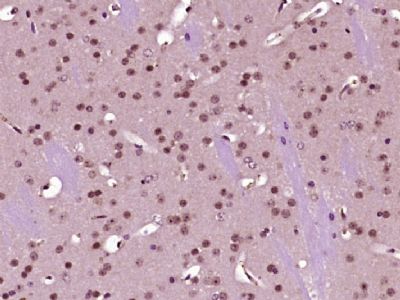p66 alpha/GATAD2A Polyclonal Antibody
Purified Rabbit Polyclonal Antibody (Pab)
- SPECIFICATION
- CITATIONS
- PROTOCOLS
- BACKGROUND

Application
| IHC-P, IHC-F, IF, ICC, E |
|---|---|
| Primary Accession | Q86YP4 |
| Host | Rabbit |
| Clonality | Polyclonal |
| Calculated MW | 68 KDa |
| Physical State | Liquid |
| Immunogen | KLH conjugated synthetic peptide derived from human p66 alpha |
| Epitope Specificity | 151-250/633 |
| Isotype | IgG |
| Purity | affinity purified by Protein A |
| Buffer | 0.01M TBS (pH7.4) with 1% BSA, 0.02% Proclin300 and 50% Glycerol. |
| SUBCELLULAR LOCATION | Nucleus speckle. |
| SIMILARITY | Contains 1 GATA-type zinc finger. |
| Important Note | This product as supplied is intended for research use only, not for use in human, therapeutic or diagnostic applications. |
| Background Descriptions | GATAD2A (GATA Zinc Finger Domain Containing 2A) is a Protein Coding gene. Among its related pathways are Activated PKN1 stimulates transcription of AR (androgen receptor) regulated genes KLK2 and KLK3 and Development NOTCH1-mediated pathway for NF-KB activity modulation. GO annotations related to this gene include transcription factor activity, sequence-specific DNA binding and protein binding, bridging. An important paralog of this gene is GATAD2B. |
| Gene ID | 54815 |
|---|---|
| Other Names | Transcriptional repressor p66-alpha, Hp66alpha, GATA zinc finger domain-containing protein 2A, GATAD2A |
| Target/Specificity | Ubiquitous, both in fetal and adult tissues. |
| Dilution | IHC-P=1:100-500,IHC-F=1:100-500,ICC=1:100-500,IF=1:100-500,ELISA=1:5000-10000 |
| Storage | Store at -20 ℃ for one year. Avoid repeated freeze/thaw cycles. When reconstituted in sterile pH 7.4 0.01M PBS or diluent of antibody the antibody is stable for at least two weeks at 2-4 ℃. |
| Name | GATAD2A |
|---|---|
| Function | Transcriptional repressor (PubMed:12183469, PubMed:16415179). Acts as a component of the histone deacetylase NuRD complex which participates in the remodeling of chromatin (PubMed:16428440, PubMed:28977666). Enhances MBD2-mediated repression (PubMed:12183469, PubMed:16415179). Efficient repression requires the presence of GATAD2B (PubMed:16415179). |
| Cellular Location | Nucleus speckle. Nucleus. Chromosome. Note=Speckled nuclear localization requires both CR1 and CR2 regions (PubMed:16415179). Localizes to sites of DNA damage in a manner partially dependent on ZMYND8 (PubMed:27732854). |
| Tissue Location | Ubiquitous, both in fetal and adult tissues. |

Thousands of laboratories across the world have published research that depended on the performance of antibodies from Abcepta to advance their research. Check out links to articles that cite our products in major peer-reviewed journals, organized by research category.
info@abcepta.com, and receive a free "I Love Antibodies" mug.
Provided below are standard protocols that you may find useful for product applications.
If you have used an Abcepta product and would like to share how it has performed, please click on the "Submit Review" button and provide the requested information. Our staff will examine and post your review and contact you if needed.
If you have any additional inquiries please email technical services at tech@abcepta.com.













 Foundational characteristics of cancer include proliferation, angiogenesis, migration, evasion of apoptosis, and cellular immortality. Find key markers for these cellular processes and antibodies to detect them.
Foundational characteristics of cancer include proliferation, angiogenesis, migration, evasion of apoptosis, and cellular immortality. Find key markers for these cellular processes and antibodies to detect them. The SUMOplot™ Analysis Program predicts and scores sumoylation sites in your protein. SUMOylation is a post-translational modification involved in various cellular processes, such as nuclear-cytosolic transport, transcriptional regulation, apoptosis, protein stability, response to stress, and progression through the cell cycle.
The SUMOplot™ Analysis Program predicts and scores sumoylation sites in your protein. SUMOylation is a post-translational modification involved in various cellular processes, such as nuclear-cytosolic transport, transcriptional regulation, apoptosis, protein stability, response to stress, and progression through the cell cycle. The Autophagy Receptor Motif Plotter predicts and scores autophagy receptor binding sites in your protein. Identifying proteins connected to this pathway is critical to understanding the role of autophagy in physiological as well as pathological processes such as development, differentiation, neurodegenerative diseases, stress, infection, and cancer.
The Autophagy Receptor Motif Plotter predicts and scores autophagy receptor binding sites in your protein. Identifying proteins connected to this pathway is critical to understanding the role of autophagy in physiological as well as pathological processes such as development, differentiation, neurodegenerative diseases, stress, infection, and cancer.


